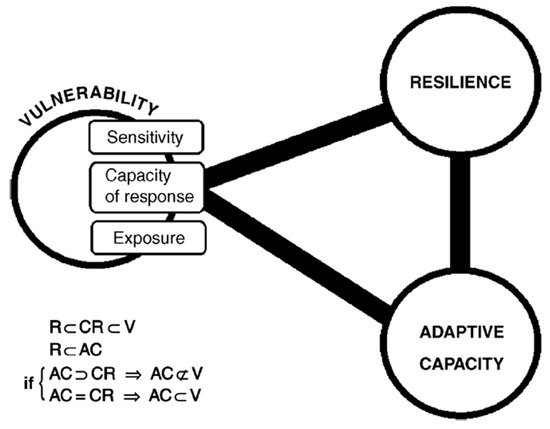The term “adaptation” is currently used in the climate field. It originated from natural science in the field of population biology and evolutionary ecology. It originally referred to the general characteristics that ensure the survival and reproduction of organic individuals in living environments. The definition of “adaptation” has many attributes, including the two most important points. First is the spatial scale of adaptation, which depends on who is responsible. Second is the nature of adaptive behavior, whether it is spontaneous or conscious or it is planned or prescriptive. The former is usually short-term and tactical adaptation, which is directly related to specific climate change. The latter is more strategic, long-term, and proactive and is usually formulated by government departments and used as part of policy adaptation measures. The adaptation to climate change in the literature is sometimes divergent at the temporal and spatial scales. Short-term adaptation is more of a reaction, and higher-scale adaptation is considered an expected adaptation through policies, projects, and recent plans and actions.
- climate change
- adaptation
- disaster risk reduction
1. Adaptation, Adaptability, and Capacity of Response

2. Adaptability, Vulnerability, and Resilience

3. Adaptation and Mitigation
References
- Dobzhansky, T. Adaptness and fitness. In Population Biology and Evolution; Lewontin, R.C., Ed.; Syracuse Univ Press: Syracuse, NY, USA, 1968; pp. 109–121.
- Smit, B.; Burton, I.; Klein, R.; Wandel, J. An anatomy of adaptation to climate change and variability. Clim. Chang. 2000, 45, 223–251.
- Smit, B.; Wandel, J. Adaptation, adaptive capacity and vulnerability. Glob. Environ. Chang. 2006, 16, 282–292.
- Huq, S.; Rahman, A.; Konate, N.; Sokona, Y.; Reid, H. Mainstreaming Adaptation to Climate changes in Least Developed Countries (LDCS), London International Institute for Environment and Development. Bangladesh Ctry. Case Study 2004, 1, 25–43.
- Risbey, J.; Kandlikar, M.; Dowlatabadi, H.; Graetz, D. Scale, context and decision making in agricultural adaptation to climate variability and change. Mitig. Adapt. Strateg. Glob. Chang. 1999, 4, 137–164.
- Smit, B.; Pilifosova, O. From Adaptation to Adaptive Capacity and Vulnerability Reduction. In Climate Change, Adaptive Capacity and Development; Smith, J.B., Klein, R.J.T., Huq, S., Eds.; Imperial College Press: London, UK, 2003.
- Yohe, G.; Strzepek, K.; Pau, T.; Yohe, C. Assessing vulnerability in the context of changing socioeconomic conditions: A study of Egypt. In Climate Change, Adaptive Capacity and Development; Smith, J.B., Kein, R.J., Huq, S., Eds.; Imperial College Press: London, UK, 2003.
- Watts, M.J.; Bohle, H.G. The space of vulnerability: The causal structure of hunger and famine. Prog. Hum. Geogr. 1993, 17, 43–67.
- Adger, W.N. Social vulnerability to climate change and extremes in coastal Vietnam. World Dev. 1999, 27, 249–269.
- Handmer, J.W.; Dovers, W.; Downing, T.E. Societal vulnerability to climate change and variability. Mitig. Adapt. Strateg. Glob. Chang. 1999, 4, 267–281.
- Wisner, B.; Blaikie, P.; Cannon, T.; Davis, I. At Risk; Routledge: London, UK, 2004.
- Larsson, J.; Harrison, S.J. Spatial specificity and inheritance of adaptation in human visual cortex. J. Neurophysiol. 2015, 114, 1211–1226.
- Li, P.; Jing, T.; Wei, D.; Ying, L. Understanding the Resilience of Different Farming Strategies in Coping with Geo-Hazards: A Case Study in Chongqing, China. Int. J. Environ. Res. Public Health 2020, 17, 1226.
- Smithers, J.; Smit, B. Human adaptation to climatic variability and change. Glob. Environ. Chang. 1997, 7, 129–146.
- Kasperson, R.E.; Dow, K.; Archer, E.; Cáceres, D.; Downing, T.; Elmqvist, T.; Eriksen, S.; Folke, C.; Han, G.; Iyengar, K.; et al. Vulnerable People and Places. In Ecosystems and Human Well-being: Current State and Trends; Hassan, R., Scholes, R., Ash, N., Eds.; Island Press: Washington, DC, USA, 2005; pp. 143–164.
- Wang, J.A.; Su, Y.; Shang, Y.Y.; Hong, S.Q.; Wang, Z.Q.; Liu, Z. Vulnerability Identification and Assessment of Agriculture Drought Disaster in China. Adv. Earth Sci. 2006, 21, 161–169.
- Adger, W.N.; Kelly, P.W.; Ninh, N.H. Living with Environmental Change: Social Resilience, Adaptation and Vulnerability in Vietnam; Routledge: London, UK, 2001.
- Jones, R. An environmental risk assessment/management framework for climate change impact assessments. Nat. Hazards 2001, 23, 197–230.
- Fraser, E.; Mabee, W.; Slaymaker, O. Mutual vulnerability, mutual dependence: The reflective notion between human society and the environment. Glob. Environ. Chang. 2003, 13, 137–144.
- Fussel, H.-M.; Klein, R.J.T. Climate change vulnerability assessment: An evolution of conceptual thinking. Clim. Chang. 2006, 75, 301–329.
- UN (United Nations). The Paris Agreement. 2015. Available online: https://unfccc.int/process-and-meetings/the-paris-agreement/the-paris-agreement (accessed on 25 December 2015).
- Brooks, N.; Adger, W.N.; Kelly, P.M. The determinants of vulnerability and adaptive capacity at the national level and the implications for adaptation. Glob. Environ. Chang. 2005, 15, 151–163.
- Ge, Q.S.; Chen, P.Q.; Fang, X.Q.; Lin, H.; Ye, Q. Adaptation to Global Change: Challenge and Research Strategy. Adv. Earth Sci. 2004, 19, 516–524.
- Gallopin, G.C. Linkages between vulnerability, resilience, and adaptive capacity. Glob. Environ. Chang. 2006, 16, 293–303.
- Adger, W.N. Vulnerability. Glob. Environ. Chang. 2006, 16, 268–281.
- IPCC. Technical Summary: Climate Change 2001: Impacts, Adaptation, and Vulnerability, A Report of Working Group II of the Intergovernmental Panel on Climate Change. Available online: http://www.grida.no/climate/ipcc_tar/wg2/pdf/wg2TARtechsum.pdf (accessed on 22 December 2010).
- Turner, B.L.; Kasperson, R.E.; Matson, P.A.; McCarthy, J.J.; Corell, R.W.; Christensen, L.; Eckley, N.; Kasperson, J.X.; Luers, A.; Martello, M.L.; et al. A framework for vulnerability analysis in sustainability science. Proc. Natl. Acad. Sci. USA 2003, 100, 8074–8079.
- Vogel, C. Vulnerability and global environmental change. LUCC Newsl. 1998, 3, 15–19.
- Lioubimtseva, E. Human dimensions of post-soviet Central Asia. Ann. Arid Zone 2009, 47, 1–24.
- Gunderson, L.H. Resilience in theory and practice. Annu. Rev. Ecol. Syst. 2000, 31, 425–439.
- Carpenter, S.; Walker, B.; Anderies, J.M.; Abel, N. From metaphor to measurement: Resilience of what to what? Ecosystems 2001, 4, 765–781.
- Folke, C.; Carpenter, S.; Elmqvist, T.; Gunderson, L.; Holling, C.S.; Waler, B. Resilience and sustainable development: Building adaptive captive capacity in a world of transformations. AMBIO 2002, 31, 437–440.
- Ford, J.D.; Berrang-Ford, L.; Biesbroek, R.; Araos, M.; Austin, S.E.; Lesnikowski, A. Adaptation tracking for a post-2015 climate agreement. Nat. Clim. Chang. 2015, 5, 967–969.
- Shi, P.J.; Li, N.; Ye, Q.; Dong, W.J.; Han, G.Y.; Fang, W.H. Research on integrated disaster risk governance in the context of global environmental change. Int. J. Disaster Risk Sci. 2010, 1, 17–23.
- Zhou, H.J.; Wang, X.; Wang, J.A. A way to sustainability: Perspective of resilience and adaptation to disaster. Sustainability 2016, 8, 737.
- Lei, Y.; Wang, J. A preliminary discussion on the opportunities and challenges of linking climate change adaptation with disaster risk reduction. Nat. Hazards 2014, 71, 1587–1597.
- Yu, J.L.; Sim, T.; Guo, C.L.; Han, Z.Q.; Lau, J.; Su, G.W. Household adaptation intentions to earthquake risks in rural China. Int. J. Disaster Risk Reduct. 2019, 40, 101253.
- IPCC. Fifth Assessment Report. 2014. Available online: https://www.ipcc.ch/report/ar5/ (accessed on 22 September 2015).
- Jaeger, C.; Shi, P.J. Core Science Initiative on Integrated Risk Governance. IHDP Update 2008, 1, 27–28.
- Mastrandrea, M.D.; Heller, N.E.; Root, T.L.; Schneider, S.H. Bridging the gap: Linking climate-impacts research with adaptation planning and management. Clim. Chang. 2010, 100, 87–101.
